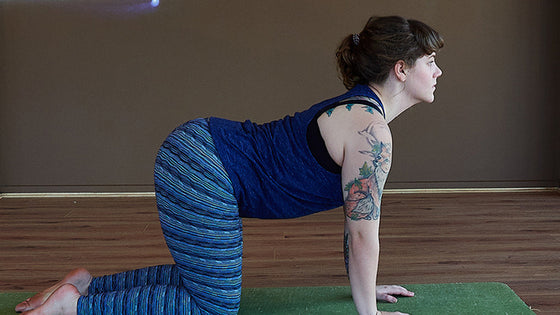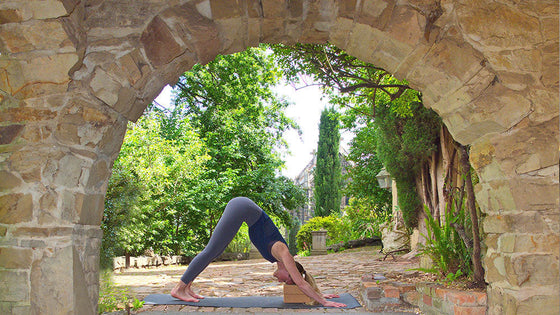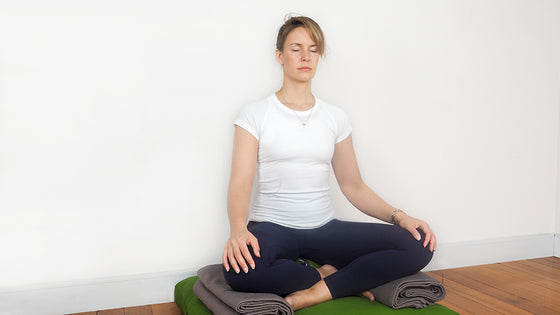- Ergonomic Products
- Ergonomic Furniture
- Yoga
- Meditation
- Pilates
- Air Treatment
- Blog
- Resources
- About Us
- Wholesale
- Ergonomic Products ▼
- Ergonomic Furniture ▼
- Yoga ▼
- Meditation ▼
- Pilates ▼
- Air Treatment ▼
- Blog
- Resources ▼
- About Us
- Wholesale
- Sign in
Downward-Facing Dog: 6 Awesome adjustments your students will love.
If we asked 100 people to name a yoga pose, Downward-Facing Dog (Adho Mukha Svanasana) would surely be the top answer. With application as both a stand-alone pose and a handy link within a flowing sequence, downward-facing dog is almost certain to show up in every active yoga class. Multi purposing as a forward bend and mild inversion, it offers the ultimate full-body, rejuvenating stretch.It’s likeability factor, however, is a little more contentious. Some students love it, and take the shape easily. Others moan and groan (or perhaps howl!) at the mere suggestion of coming into downward facing dog.
Whichever camp students fall into, there’s always more to love and learn about any pose. Experiencing an appropriate adjustment at the hands of a caring and confident teacher can help students achieve both.
The grounds for adjustment
Adjustments are used to help yoga students find better alignment, ease, stability, understanding and extension in a variety of poses. They can either utilise props or be a hands-on experience - sometimes both.
Now, let’s explore 6 adjustments that are sure to convert all your students to ardent dog lovers!
1. Lend a grounding hand
Many students place too much weight into the wrists and outer hands in downward-facing dog, potentially leading to soreness and misalignment. This grounding guidance highlights the stabilising role of the whole of the hands and fingers, and helps strengthen the muscles of the fingers, hands and arms.
Adjustment: Gently press your partner’s hands down to the earth with your own.

2. Support high heels
Students with tight hamstrings will likely take downward-facing dog with their heels far from earth. Those with tight achilles may even get the leg shakes! Create a soft, supportive landing pad for the heels with a rolled mat or blanket. This gives the student a focus for the desired direction of the heels - straight back and down to earth - and also frees up the entire body.
Adjustment: Pop the prop under the heels and ask your student to sink into it.

3. Roll out the shoulders
Scrunching tight shoulders up around the ears is a common issue - on and off the yoga mat. This adjustment gifts the shoulders well-deserved spaciousness and allows the neck to lengthen.
Adjustment: Place your hands on the student’s upper arms and rotate armpits toward one another.

4. Lift and lighten
With the weight distributed between hands and feet, there’s a temptation to feel heavy in this pose. This adjustment delivers a joyful sense of lightness, height and a delightful tractioning out of the spine.
Adjustment: Stand with one foot between the student’s hands, the other staggered behind. Match the heels of your hands with their sacrum, spread the hands and lean your weight toward the student as you direct the sacrum upward.

5. Power up the legs
Downward-facing dog requires lots of leg power! The blend of pressure and direction from the belt in this adjustment reminds the student to activate the front of the legs and shift them toward the backs of the legs. This adjustment encourages an even weight distribution between arms and legs, and lengthens out the spine.
Adjustment: Standing as above, loop a belt around the top of her thighs—holding the ends of the belt gently, lean back to lengthen the spine. Make sure the student can comfortably maintain contact with the floor throughout the adjustment.

6. Quiet the mind
As a stand-alone and sequence linking pose, downward-facing dog is not generally considered quiet and restorative. But with the addition of a squishy bolster under the forehead, the pose can be transformed into a tranquil body/mind soother. This light pressure against the forehead is also useful to relieve headache.
Adjustment: Place the short edge of the bolster under the pose for the head to rest on. Be sure to adjust the height (use 2 bolsters) if necessary so the props easily meet the body, rather than vice-versa.

Rules of adjustment
Before offering adjustments to students, be mindful of the following rules of adjustment:
Practice makes perfect
Offering adjustments in your class will help you, as a teacher, learn so much more about the poses and your students. Mastering a few adjustments with one of yoga’s most recognised poses, downward-facing dog, is a great place to start.
Best of all, your students get to experience progression and ‘light bulb moments’ in their practice, which will have them fall in love with even the most challenging poses.
A quality yoga mat that that has excellent grip is a great asset to your practice of yoga asanas, especially one such as Downward Facing Dog-check out the Earth Fusion mat on our website.


